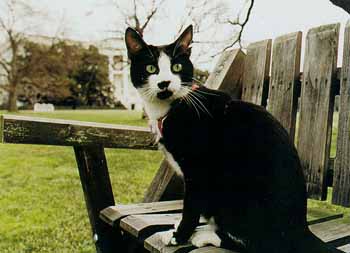

Custom Search
|
 Chelsea Clinton's cat, Socks, is a bicolor cat, or tuxedo cat who lived in the
White House from 1993 to 2001
Chelsea Clinton's cat, Socks, is a bicolor cat, or tuxedo cat who lived in the
White House from 1993 to 2001A bicolor cat has white fur combined with fur of some other colour, for example black —- in this case they are often referred to as a tuxedo cat. Bicolours are found in many breeds as well as being common in domestic longhair cats and domestic shorthair cats.
Bicolour occurs because there is a white spotting gene present along with a recessive allele of the agouti gene, which evens out the usual striped pattern of the colours of the coat. In contrast, tabby cats have an agouti gene that produces striping of the coat. The Abyssinian has agouti with dilution (ticked tabby), giving the appearance of even colour with colour-banded hairs.
A black-and-white bicolour cat is often known as a tuxedo cat or a Jellicle cat. To be considered a “tuxedo”, its black coloring should be solid through out, with white limited to the paws, belly, chest, throat, and possibly the chin. The tuxedo name is just that. It should appear as if the cat is wearing a tuxedo. Some owners attribute shy personalities to tuxedo cats, particularly once they reach adulthood.
Another type of black-and-white bicolour cat is called a “cow cat” or “moo cat”. A cow cat doesn't have the solid black 'jacket' of the tuxedo cat. Instead, it has big black patches over a mostly white body, often with a black mask over the head. Some owners attribute chacteristics such as a love of water, big personalities and a playful nature to cow cats.
Black Mask Cats are another variant of the cow cat or tuxedo cat, so called because they look like they are wearing a black mask over their head.
The Turkish Van (white and red) is one good example of a bicolour breed.
bicolor cat white fur combined fur other color black tuxedo cat Bicolor many breeds domestic longhair cats domestic shorthair cats